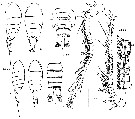|
|
 |
Fiche d'espèce de Copépode |
|
|
Calanoida ( Ordre ) |
|
|
|
Epacteriscoidea ( Superfamille ) |
|
|
|
Ridgewayiidae ( Famille ) |
|
|
|
Ridgewayia ( Genre ) |
|
|
| |
Ridgewayia tortuga Figueroa, 2011 (F,M) | |
| | | | | | | Ref.: | | | Figueroa, 2011 (p.154, figs.F,M, Rem.: Biol. mol.) |  issued from : D.F. Figueroa in J. Crustacean Biol., 2011, 31 (1) [p.156, Fig.1] Female (from 24°37.6'N, 82°52.3'W): A-B, habitus (lateral and dorsal, respectivelt); C, urosome (ventral); D, A1. Male: E-F, habitus (lateral and dorsal, respectively); G, urosome (ventral); H, right A1; I, right A1, segments 6-12 with schematic of muscle pattern near first geniculation.
|
 issued from : D.F. Figueroa in J. Crustacean Biol., 2011, 31 (1) [p.157, Fig.2] Female: A, A2; B, Md; C, Mx1; D, Mx2; E, Mxp.
|
 issued from : D.F. Figueroa in J. Crustacean Biol., 2011, 31 (1) [p.158, Fig.3, A-G] Female: A-E, P1 to P5, rspectively (anterior views). Male: F, right P5 (posterior view); G, left P5 (anterior view).
|
 issued from : D.F. Figueroa in J. Crustacean Biol., 2011, 31 (1) [p.158, Table 2] Female: Setae (Arabic nulerals) and spines (Roman numerals) formulae for legs P1 to P5.
| | | | | NZ: | 1 | | |
|
Carte de distribution de Ridgewayia tortuga par zones géographiques
|
| | | | Loc: | | | NW Atlantic (Garden Key: Dry Tortugas, Florida Keys) | | | | N: | 1 | | | | Lg.: | | | (1069) F: 0,77-0,78; M: 0,68; {F: 0,77-0,78; M: 0,68} | | | | Rem.: | In Coral rubble (intertidal zone).
See remarks in Rigdgewayia sp. Yeatman (1969).
For Figueroa (2011, p.159) The geniculation in male of R. tortuga and Hondurella verrucosa (Suarez-Morales & Iliffe, 2007) with 11 segments beyond the geniculation contrasts the usual position in the family with only 4 segments beyond the geniculation (Boxshall & Halsey, 2004).
For the author the species most closely resembles members of the typica-group, sharing two of the three characters used by Barthélémy & al. (1998) to define it: 1- lack of an inner seta on the coxa of P1 (this seta is present in members of the marki- and gracilis- groups); 2- presence of only 1 outer spine on the distal exopod segment of the male right P5 (2 outer spines are present in species of the marki- and gracilis groups). There are two key differences that set R. tortuga apart from all other Ridgewayia: 1- males of tortuga have a 20-segmented, doubly geniculate, right A1 (a single geniculation is present in all other species with 21-24 articulated segments); 2- the 3rd endopod segment on P2 of tortuga has 7 setae (all other species have 8).
There are two previous descriptions of undetermined specimens of male Ridgewayia that are similar to R. tortuga. Yeatman (1969) described one male Ridgewayia sp. from Bermuda and Por (1979) described sevaral males from the Bitter Lakes (Suez Canal). P5 males described by Yeatman and Por are remarkably similar to that of R. tortuga . The segmentation and armature of P5 are the same, except for the presence of a small outer seta on the basis of Yeatman's specimen. This seta is absent in Por's drawing and in R. tortuga. The left endopod has the same oblong shape with a distal tooth-like element in all three. The right P5 inR. tortuga and Yeatman's and Por's specimens also have the same segmentation and armature, except for a thin seta present on the inner margin of the 1st exopod segment as shown on Yeatman's drawing; in R. tortuga and Por's specimen there is a patch of fine setae on this inner margin. The right endopod has the same elongated shape with a forked tip at the end in all three males. Yeatman's described a set of fine seta-like structures on this forked tip, not present in R. tortuga or in Por's drawing. Yeatman's and Por's specimens are depicted as having an unequally bifurcated tip, while R. tortuga has a symmetrically bifurcated tip. Yeatman's specimen has a 22-segmented right A1, while R. tortuga has only 20 segments. The swimming legs in both have the same segmentation and armature that include only 7 setae on the terminal exopod segment of P2 instead of the 8 found in all other Ridgewayia. The unusual geniculation on the right A1 of the male of R. tortuga between articulated segments 9 and 10 (with 11 segments beyond the geniculation) is not mentioned by Yeatman (1969) nor has it been observed in any other species of Ridgewayia; but such a geniculation has been found elsewhere in Ridgewayiidae (see Hondurella verrucosa). The position of the geniculation in R. tortuga and H. verrucosa with 11 segments beyond the geniculation contrasts the usual position in the family with only 4 segments beyond the geniculation (Boxshall & Halsey, 2004). | | | Dernière mise à jour : 28/06/2013 | |
|
|
 Toute utilisation de ce site pour une publication sera mentionnée avec la référence suivante : Toute utilisation de ce site pour une publication sera mentionnée avec la référence suivante :
Razouls C., Desreumaux N., Kouwenberg J. et de Bovée F., 2005-2024. - Biodiversité des Copépodes planctoniques marins (morphologie, répartition géographique et données biologiques). Sorbonne Université, CNRS. Disponible sur http://copepodes.obs-banyuls.fr [Accédé le 20 avril 2024] © copyright 2005-2024 Sorbonne Université, CNRS
|
|
 |
 |






